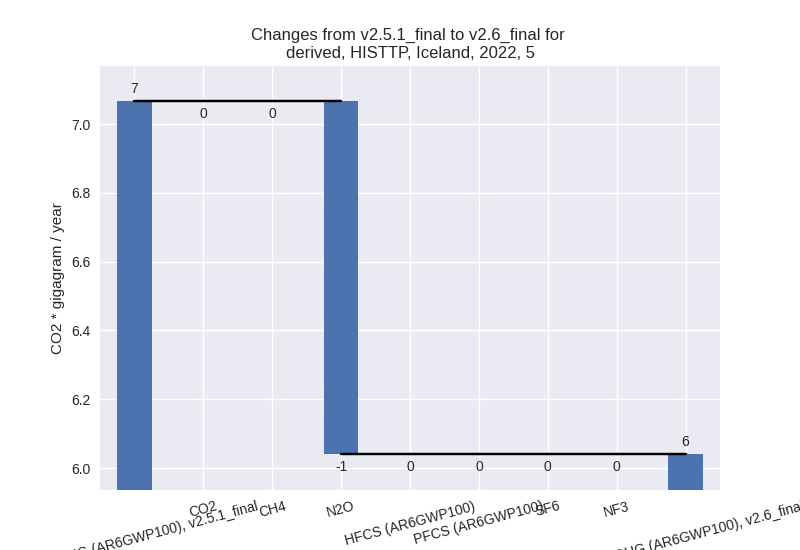Changes in PRIMAP-hist v2.6_final compared to v2.5.1_final for Iceland
2024-09-24
Johannes Gütschow
Change analysis for Iceland for PRIMAP-hist v2.6_final compared to v2.5.1_final
Overview over emissions by sector and gas
The following figures show the aggregate national total emissions excluding LULUCF AR6GWP100 for the country reported priority scenario. The dotted linesshow the v2.5.1_final data.
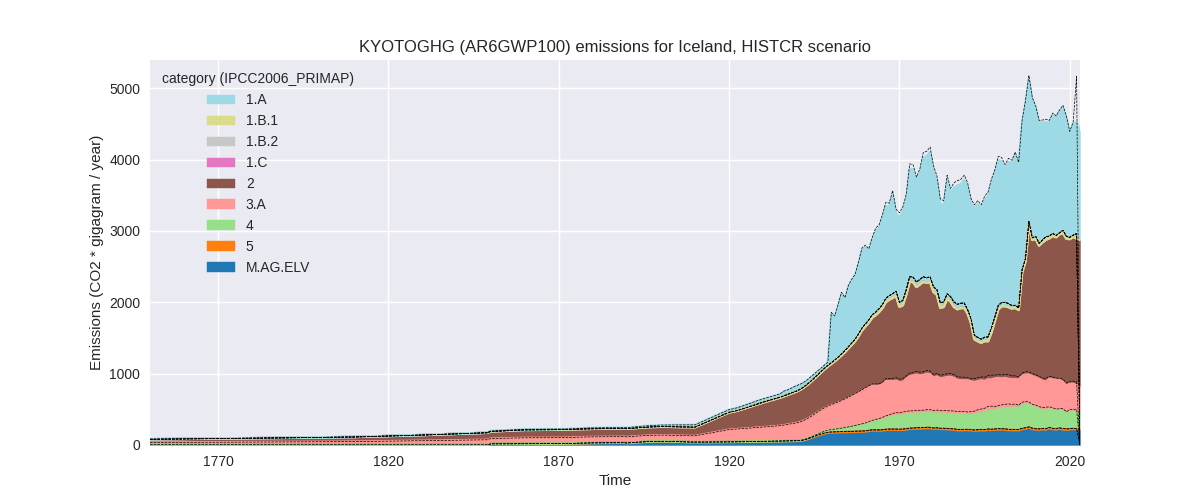

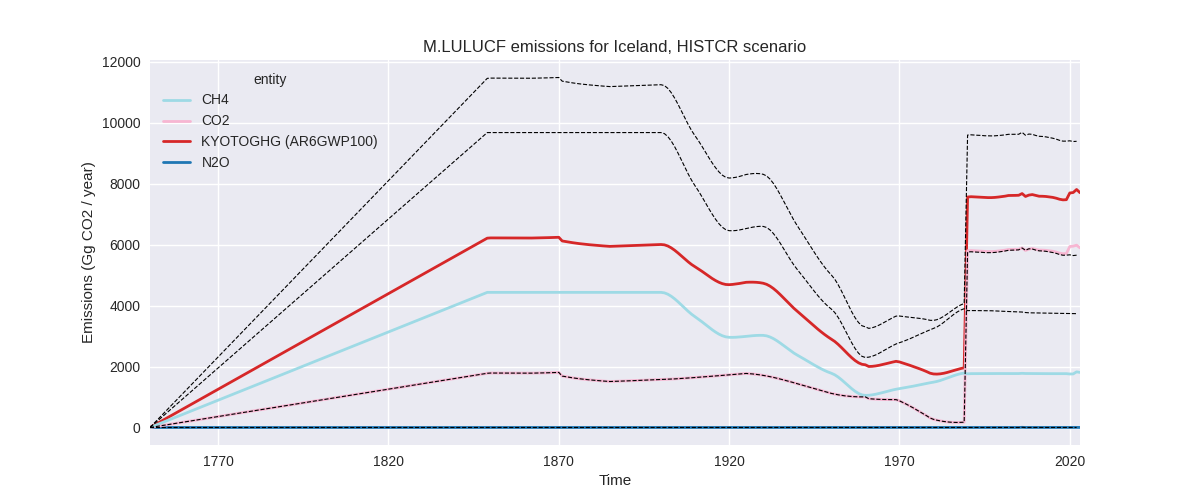
The following figures show the aggregate national total emissions excluding LULUCF AR6GWP100 for the third party priority scenario. The dotted linesshow the v2.5.1_final data.

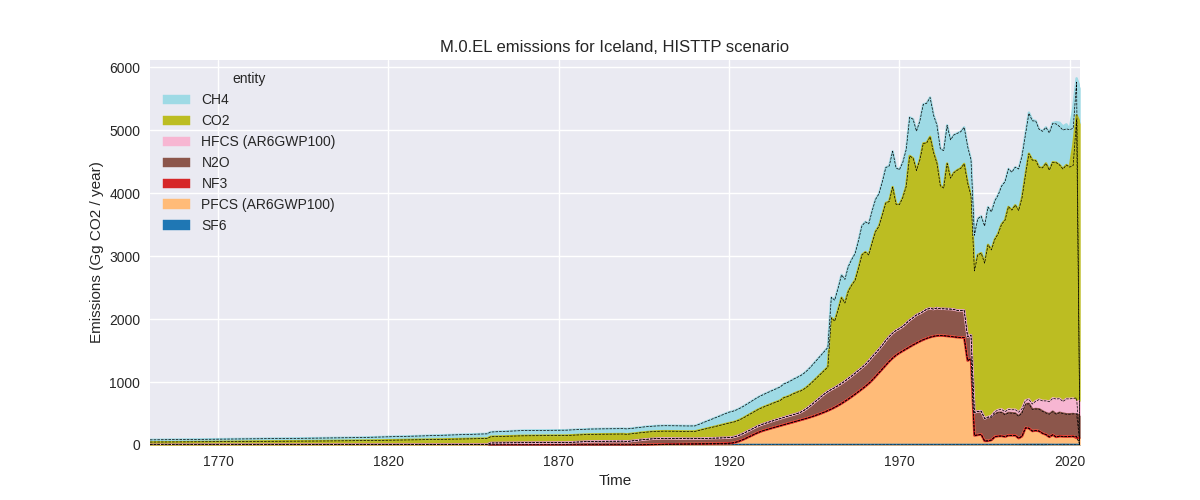
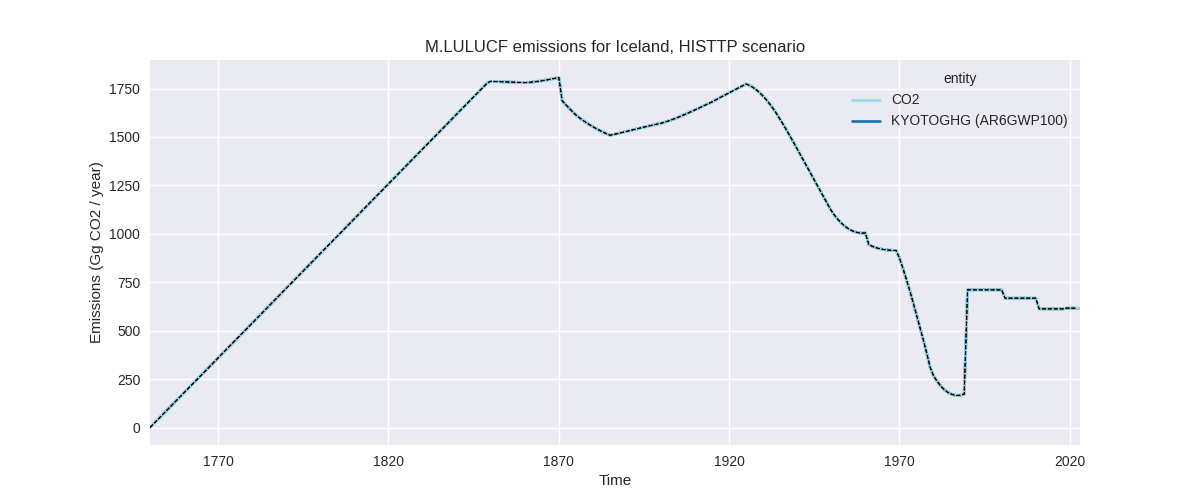
Overview over changes
In the country reported priority scenario we have the following changes for aggregate Kyoto GHG and national total emissions excluding LULUCF (M.0.EL):
- Emissions in 2022 have changed by -11.6%% (-618.86 Gg CO2 / year)
- Emissions in 1990-2022 have changed by -1.3%% (-58.97 Gg CO2 / year)
In the third party priority scenario we have the following changes for aggregate Kyoto GHG and national total emissions excluding LULUCF (M.0.EL):
- Emissions in 2022 have changed by 1.1%% (62.02 Gg CO2 / year)
- Emissions in 1990-2022 have changed by 0.4%% (19.46 Gg CO2 / year)
Most important changes per scenario and time frame
In the country reported priority scenario the following sector-gas combinations have the highest absolute impact on national total KyotoGHG (AR6GWP100) emissions in 2022 (top 5):
- 1: 1.A, CO2 with -567.55 Gg CO2 / year (-26.1%)
- 2: 2, HFCS (AR6GWP100) with -66.85 Gg CO2 / year (-30.0%)
- 3: 2, CO2 with 50.91 Gg CO2 / year (2.9%)
- 4: 4, CH4 with -38.35 Gg CO2 / year (-15.1%)
- 5: 1.B.3, CO2 with 22.85 Gg CO2 / year (14.0%)
In the country reported priority scenario the following sector-gas combinations have the highest absolute impact on national total KyotoGHG (AR6GWP100) emissions in 1990-2022 (top 5):
- 1: 4, CH4 with -34.27 Gg CO2 / year (-11.7%)
- 2: 1.A, CO2 with -17.26 Gg CO2 / year (-0.9%)
- 3: M.AG.ELV, N2O with -8.94 Gg CO2 / year (-4.0%)
- 4: 2, N2O with 8.16 Gg CO2 / year (50.8%)
- 5: 2, HFCS (AR6GWP100) with -5.39 Gg CO2 / year (-5.3%)
In the third party priority scenario the following sector-gas combinations have the highest absolute impact on national total KyotoGHG (AR6GWP100) emissions in 2022 (top 5):
- 1: 1.A, CO2 with 107.66 Gg CO2 / year (4.1%)
- 2: 2, HFCS (AR6GWP100) with -47.88 Gg CO2 / year (-19.2%)
- 3: 2, PFCS (AR6GWP100) with -23.00 Gg CO2 / year (-17.3%)
- 4: 1.B.3, CO2 with 22.85 Gg CO2 / year (14.0%)
- 5: 4, CH4 with 3.59 Gg CO2 / year (1.4%)
In the third party priority scenario the following sector-gas combinations have the highest absolute impact on national total KyotoGHG (AR6GWP100) emissions in 1990-2022 (top 5):
- 1: 1.A, CO2 with 12.54 Gg CO2 / year (0.6%)
- 2: 4, CH4 with 8.56 Gg CO2 / year (3.4%)
- 3: 2, HFCS (AR6GWP100) with -1.45 Gg CO2 / year (-1.4%)
- 4: 2, PFCS (AR6GWP100) with -0.70 Gg CO2 / year (-0.3%)
- 5: 1.B.3, CO2 with 0.69 Gg CO2 / year (0.5%)
Notes on data changes
Here we list notes explaining important emissions changes for the country. ’' means that the following text only applies to the TP time series, while means that it only applies to the CR scenario. Otherwise the note applies to both scenarios.
- We have added EEA 2024 inventory data.
- The high reduction in energy CO2 comes from EEA2024 data which does not show the steep 2022 increase in emissions EI2023 shows. (CR)
- For HFCs EEA2024 data replaces the extrapolated value from v2.5.1 leading to lower emissions in 2022 (CR and TP)
- CH4 from waste is lower for all years in EEA2024 than in CRF2023 leading to lower emission in PRIMAP-hist v2.6 (CR)
- N2O from Chemical industry was 0 since 2002 in CRF2023 and PRIMAP-hist v2.5.1. In EEA2024 it is marked as NaN and thus takes from EDGAR 8.0 for PRIMAP-hist v2.6 leading to higher emissions (CR).
- More changes to 2022 emissions due to the updated country reported data (F-gases, CO2 in 1.B.3) (CR, TP)
Changes by sector and gas
For each scenario and time frame the changes are displayed for all individual sectors and all individual gases. In the sector plot we use aggregate Kyoto GHGs in AR6GWP100. In the gas plot we usenational total emissions without LULUCF. ## country reported scenario
2022

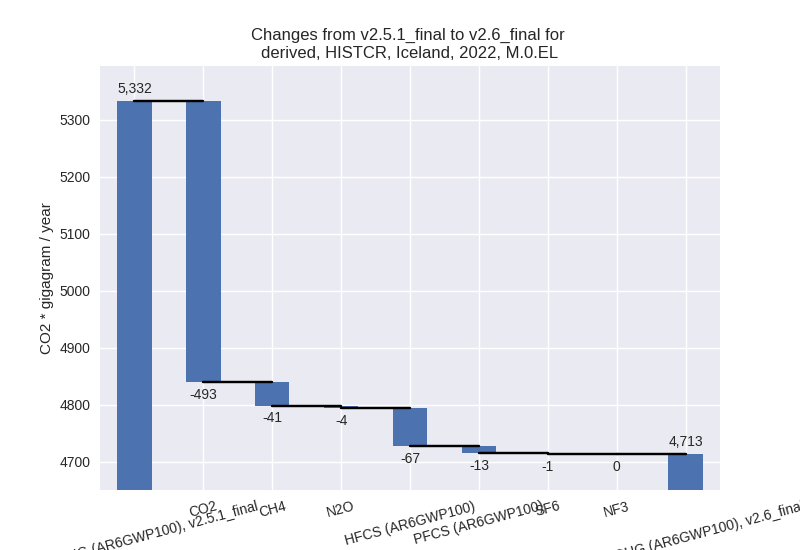
1990-2022
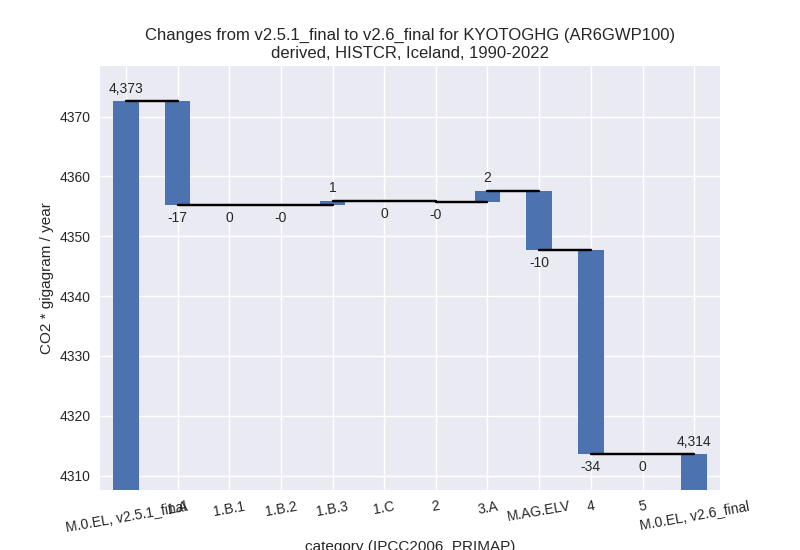

third party scenario
2022
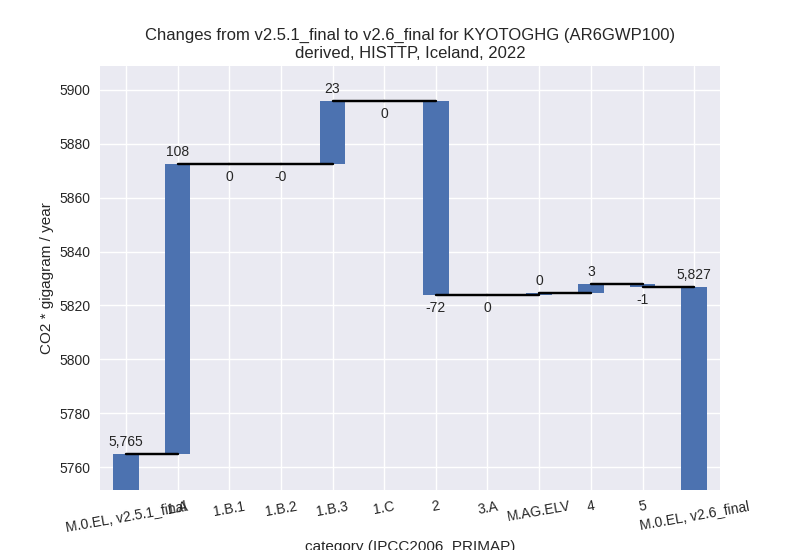
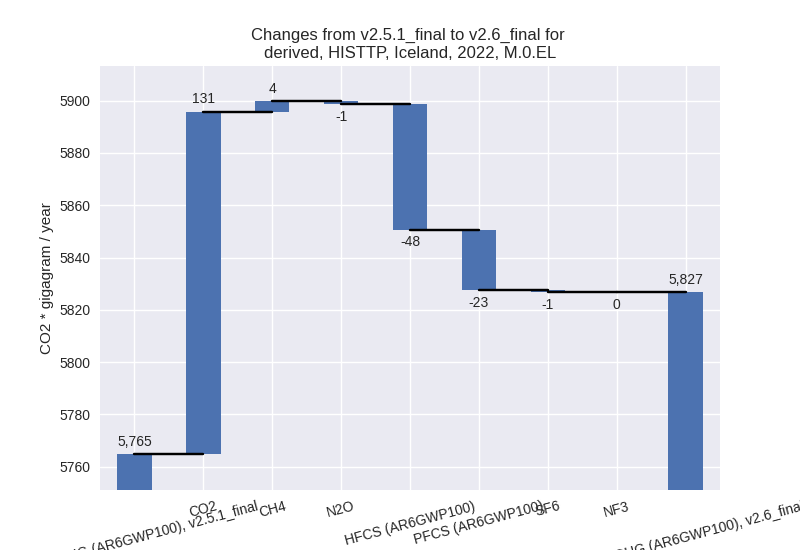
1990-2022
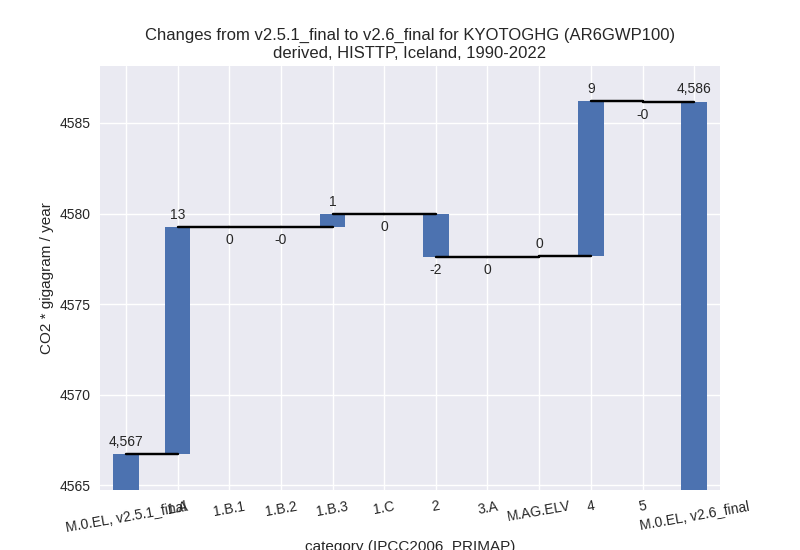
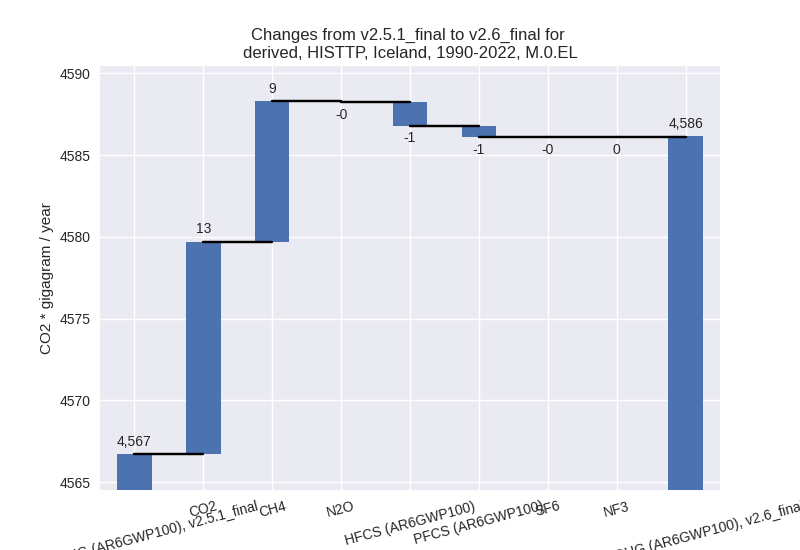
Detailed changes for the scenarios:
country reported scenario (HISTCR):
Most important changes per time frame
For 2022 the following sector-gas combinations have the highest absolute impact on national total KyotoGHG (AR6GWP100) emissions in 2022 (top 5):
- 1: 1.A, CO2 with -567.55 Gg CO2 / year (-26.1%)
- 2: 2, HFCS (AR6GWP100) with -66.85 Gg CO2 / year (-30.0%)
- 3: 2, CO2 with 50.91 Gg CO2 / year (2.9%)
- 4: 4, CH4 with -38.35 Gg CO2 / year (-15.1%)
- 5: 1.B.3, CO2 with 22.85 Gg CO2 / year (14.0%)
For 1990-2022 the following sector-gas combinations have the highest absolute impact on national total KyotoGHG (AR6GWP100) emissions in 1990-2022 (top 5):
- 1: 4, CH4 with -34.27 Gg CO2 / year (-11.7%)
- 2: 1.A, CO2 with -17.26 Gg CO2 / year (-0.9%)
- 3: M.AG.ELV, N2O with -8.94 Gg CO2 / year (-4.0%)
- 4: 2, N2O with 8.16 Gg CO2 / year (50.8%)
- 5: 2, HFCS (AR6GWP100) with -5.39 Gg CO2 / year (-5.3%)
Changes in the main sectors for aggregate KyotoGHG (AR6GWP100) are
- 1: Total sectoral emissions in 2022 are 1819.82 Gg
CO2 / year which is 38.6% of M.0.EL emissions. 2022 Emissions have
changed by -23.2% (-550.74 Gg CO2 /
year). 1990-2022 Emissions have changed by -0.8% (-16.65 Gg CO2 / year). For 2022 the
changes per gas
are:

The changes come from the following subsectors:- 1.A: Total sectoral emissions in 2022 are 1628.80
Gg CO2 / year which is 100.0% of category 1 emissions. 2022 Emissions
have changed by -26.1% (-574.04 Gg
CO2 / year). 1990-2022 Emissions have changed by -0.9% (-17.36 Gg CO2 / year). For 2022 the
changes per gas
are:
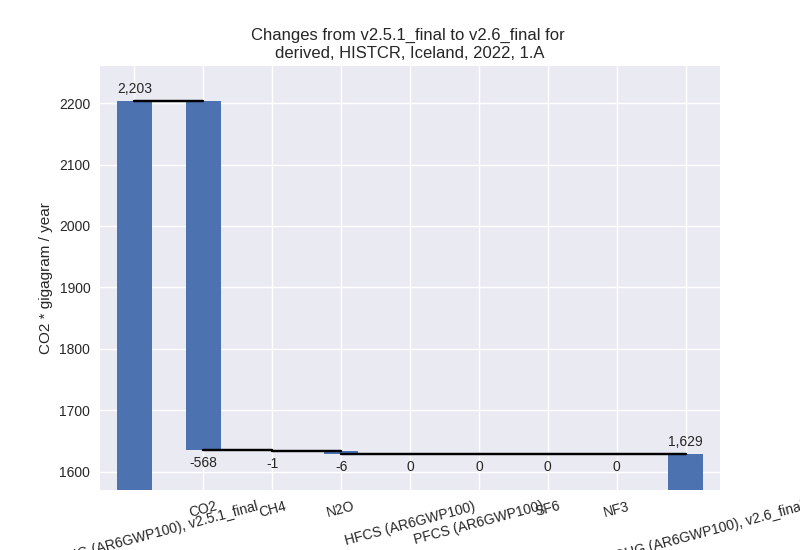
There is no subsector information available in PRIMAP-hist. - 1.B.2: Total sectoral emissions in 2022 are 0.60 Gg
CO2 / year which is 0.0% of category 1 emissions. 2022 Emissions have
changed by -10.8% (-0.07 Gg CO2 /
year). 1990-2022 Emissions have changed by -0.4% (-0.00 Gg CO2 / year). For 2022 the
changes per gas
are:
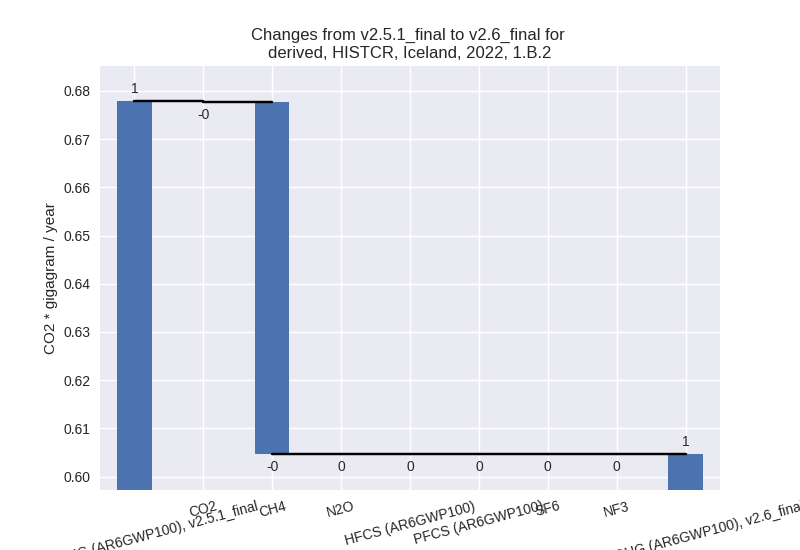
There is no subsector information available in PRIMAP-hist.
- 1.A: Total sectoral emissions in 2022 are 1628.80
Gg CO2 / year which is 100.0% of category 1 emissions. 2022 Emissions
have changed by -26.1% (-574.04 Gg
CO2 / year). 1990-2022 Emissions have changed by -0.9% (-17.36 Gg CO2 / year). For 2022 the
changes per gas
are:
- 2: Total sectoral emissions in 2022 are 2059.53 Gg CO2 / year which is 43.7% of M.0.EL emissions. 2022 Emissions have changed by -0.8% (-16.25 Gg CO2 / year). 1990-2022 Emissions have changed by -0.0% (-0.19 Gg CO2 / year).
- M.AG: Total sectoral emissions in 2022 are 600.98
Gg CO2 / year which is 12.8% of M.0.EL emissions. 2022 Emissions have
changed by -2.5% (-15.57 Gg CO2 /
year). 1990-2022 Emissions have changed by -1.2% (-7.96 Gg CO2 / year). For 2022 the
changes per gas
are:
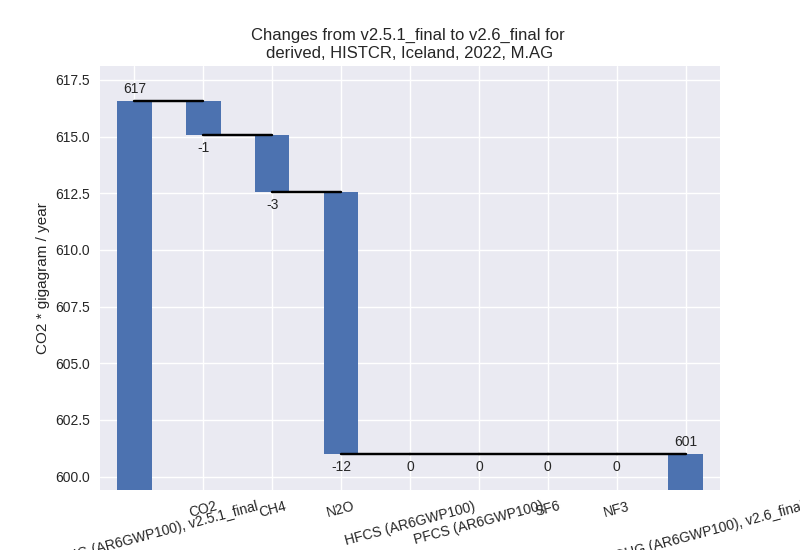
The changes come from the following subsectors:- 3.A: Total sectoral emissions in 2022 are 383.16 Gg CO2 / year which is 63.8% of category M.AG emissions. 2022 Emissions have changed by -0.7% (-2.58 Gg CO2 / year). 1990-2022 Emissions have changed by 0.4% (1.86 Gg CO2 / year).
- M.AG.ELV: Total sectoral emissions in 2022 are
217.82 Gg CO2 / year which is 36.2% of category M.AG emissions. 2022
Emissions have changed by -5.6%
(-12.99 Gg CO2 / year). 1990-2022 Emissions have changed by -4.3% (-9.83 Gg CO2 / year). For 2022 the
changes per gas
are:
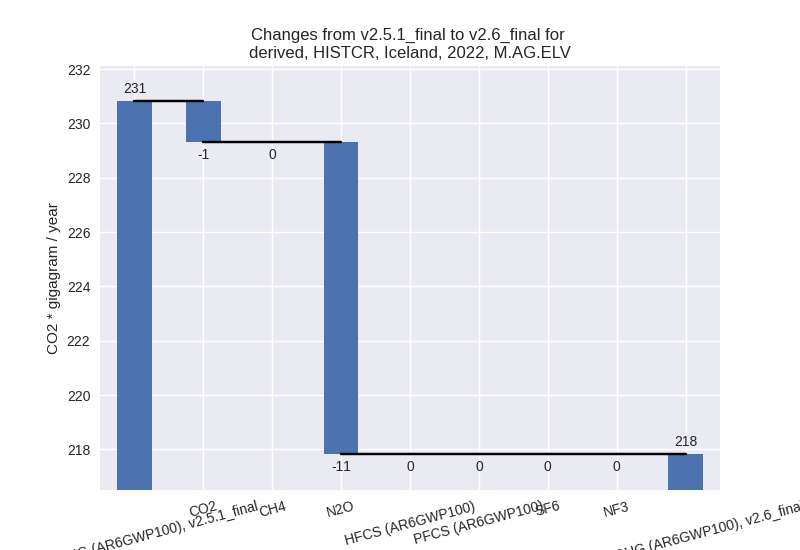
For 1990-2022 the changes per gas are: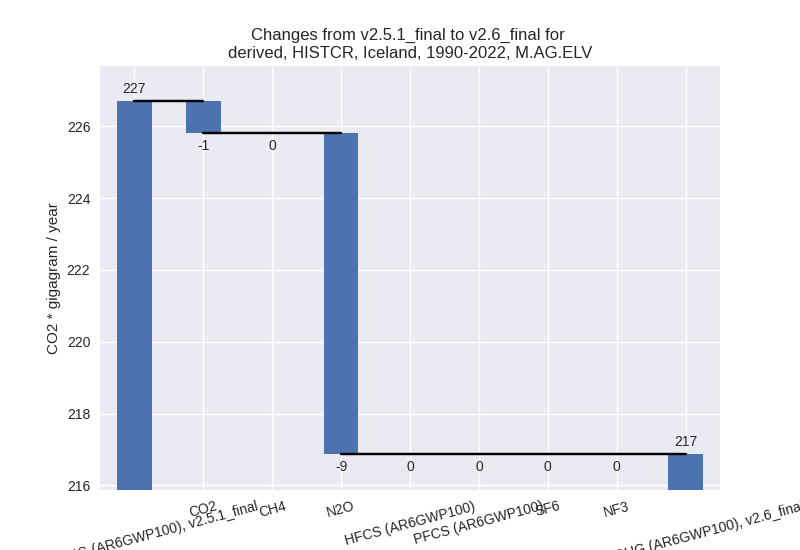
There is no subsector information available in PRIMAP-hist.
- 4: Total sectoral emissions in 2022 are 233.03 Gg
CO2 / year which is 4.9% of M.0.EL emissions. 2022 Emissions have
changed by -13.5% (-36.30 Gg CO2 /
year). 1990-2022 Emissions have changed by -11.2% (-34.16 Gg CO2 / year). For 2022
the changes per gas
are:
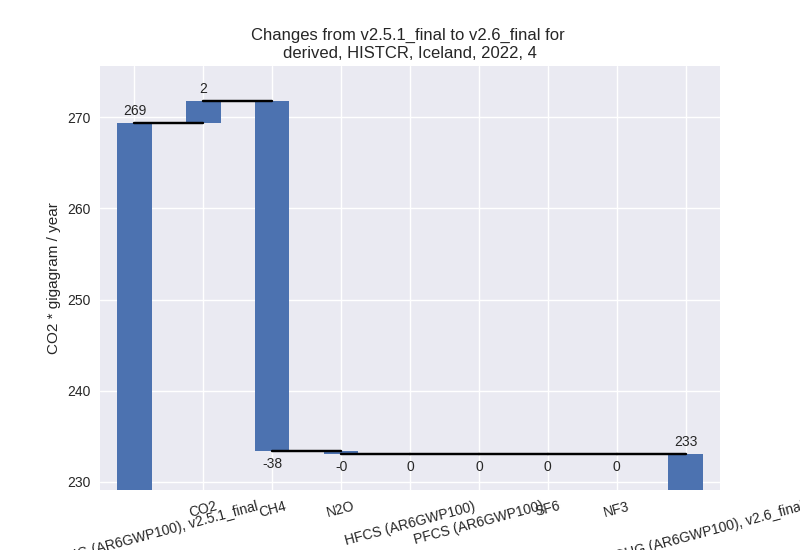
For 1990-2022 the changes per gas are: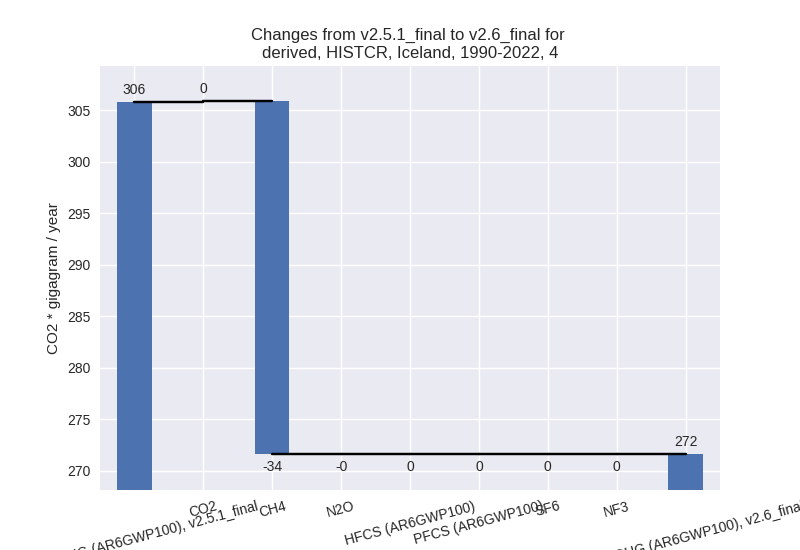
- 5: No data
third party scenario (HISTTP):
Most important changes per time frame
For 2022 the following sector-gas combinations have the highest absolute impact on national total KyotoGHG (AR6GWP100) emissions in 2022 (top 5):
- 1: 1.A, CO2 with 107.66 Gg CO2 / year (4.1%)
- 2: 2, HFCS (AR6GWP100) with -47.88 Gg CO2 / year (-19.2%)
- 3: 2, PFCS (AR6GWP100) with -23.00 Gg CO2 / year (-17.3%)
- 4: 1.B.3, CO2 with 22.85 Gg CO2 / year (14.0%)
- 5: 4, CH4 with 3.59 Gg CO2 / year (1.4%)
For 1990-2022 the following sector-gas combinations have the highest absolute impact on national total KyotoGHG (AR6GWP100) emissions in 1990-2022 (top 5):
- 1: 1.A, CO2 with 12.54 Gg CO2 / year (0.6%)
- 2: 4, CH4 with 8.56 Gg CO2 / year (3.4%)
- 3: 2, HFCS (AR6GWP100) with -1.45 Gg CO2 / year (-1.4%)
- 4: 2, PFCS (AR6GWP100) with -0.70 Gg CO2 / year (-0.3%)
- 5: 1.B.3, CO2 with 0.69 Gg CO2 / year (0.5%)
Changes in the main sectors for aggregate KyotoGHG (AR6GWP100) are
- 1: Total sectoral emissions in 2022 are 2956.96 Gg
CO2 / year which is 50.7% of M.0.EL emissions. 2022 Emissions have
changed by 4.6% (130.96 Gg CO2 /
year). 1990-2022 Emissions have changed by 0.6% (13.25 Gg CO2 / year). For 2022 the
changes per gas
are:
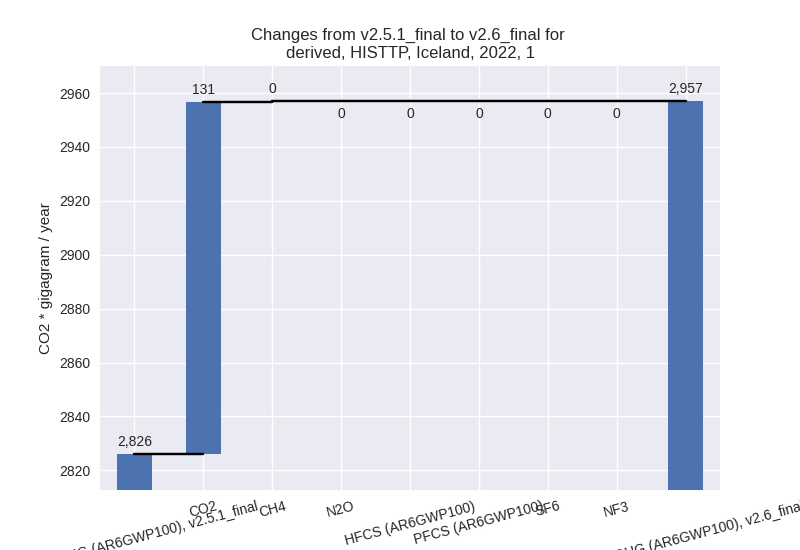
The changes come from the following subsectors:- 1.A: Total sectoral emissions in 2022 are 2765.93
Gg CO2 / year which is 100.0% of category 1 emissions. 2022 Emissions
have changed by 4.1% (107.66 Gg CO2
/ year). 1990-2022 Emissions have changed by 0.6% (12.54 Gg CO2 / year). For 2022 the
changes per gas
are:
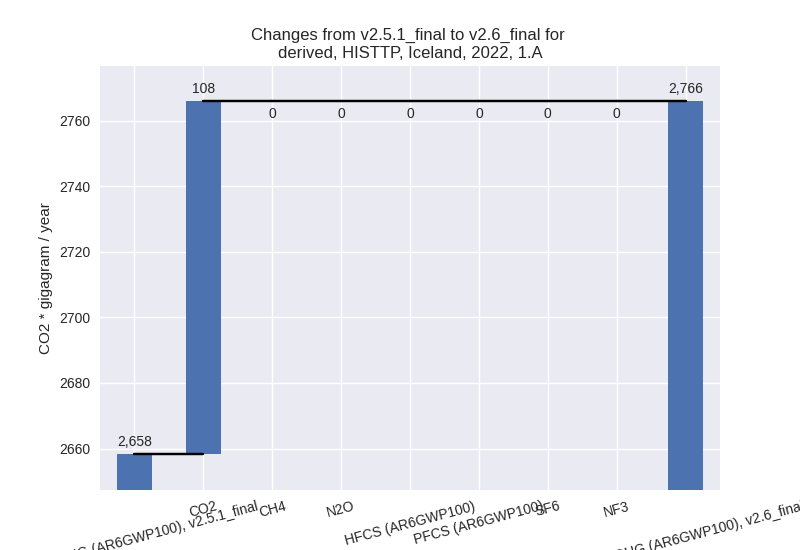
There is no subsector information available in PRIMAP-hist. - 1.B.2: Total sectoral emissions in 2022 are 0.60 Gg
CO2 / year which is 0.0% of category 1 emissions. 2022 Emissions have
changed by -10.8% (-0.07 Gg CO2 /
year). 1990-2022 Emissions have changed by -0.4% (-0.00 Gg CO2 / year). For 2022 the
changes per gas
are:
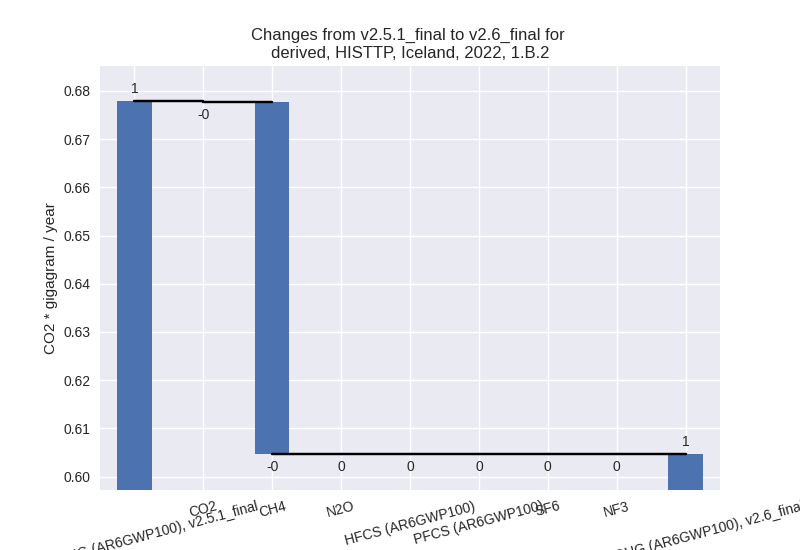
There is no subsector information available in PRIMAP-hist.
- 1.A: Total sectoral emissions in 2022 are 2765.93
Gg CO2 / year which is 100.0% of category 1 emissions. 2022 Emissions
have changed by 4.1% (107.66 Gg CO2
/ year). 1990-2022 Emissions have changed by 0.6% (12.54 Gg CO2 / year). For 2022 the
changes per gas
are:
- 2: Total sectoral emissions in 2022 are 1961.47 Gg
CO2 / year which is 33.7% of M.0.EL emissions. 2022 Emissions have
changed by -3.5% (-71.76 Gg CO2 /
year). 1990-2022 Emissions have changed by -0.2% (-2.34 Gg CO2 / year). For 2022 the
changes per gas
are:
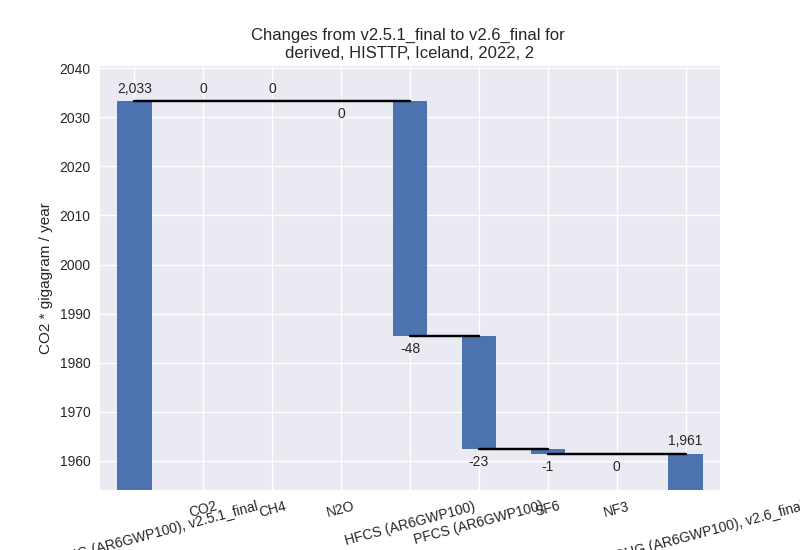
- M.AG: Total sectoral emissions in 2022 are 624.99 Gg CO2 / year which is 10.7% of M.0.EL emissions. 2022 Emissions have changed by 0.1% (0.45 Gg CO2 / year). 1990-2022 Emissions have changed by 0.0% (0.03 Gg CO2 / year).
- 4: Total sectoral emissions in 2022 are 277.35 Gg
CO2 / year which is 4.8% of M.0.EL emissions. 2022 Emissions have
changed by 1.2% (3.38 Gg CO2 /
year). 1990-2022 Emissions have changed by 3.3% (8.54 Gg CO2 / year). For 1990-2022
the changes per gas
are:
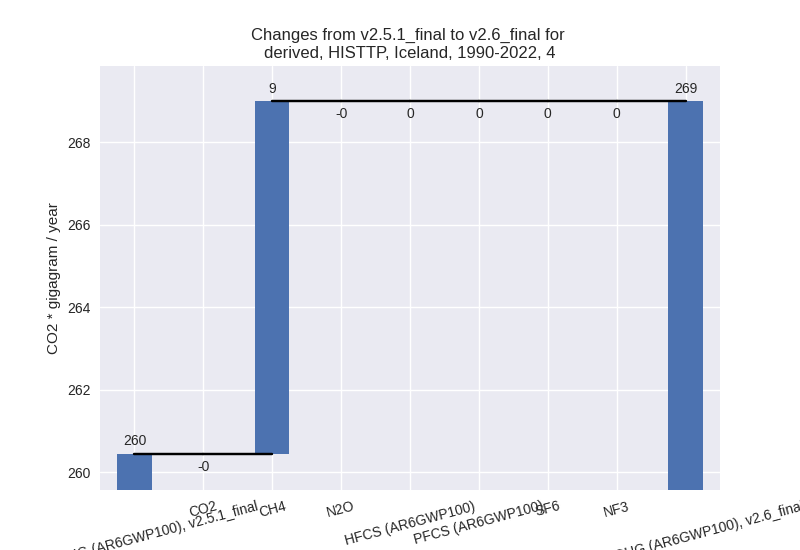
- 5: Total sectoral emissions in 2022 are 6.04 Gg CO2
/ year which is 0.1% of M.0.EL emissions. 2022 Emissions have changed by
-14.5% (-1.03 Gg CO2 / year).
1990-2022 Emissions have changed by -0.3% (-0.03 Gg CO2 / year). For 2022 the
changes per gas
are:
